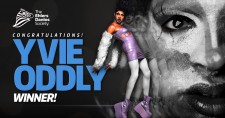
Yvie Oddly Wins the Hearts of the EDS Community
BALTIMORE, May 31, 2019 (Newswire.com) - The Ehlers-Danlos Society congratulates Yvie Oddly for taking the crown at the finale of RuPaul’s Drag Race Season 11. Yvie has chosen to live publicly with Ehlers-Danlos syndrome (EDS), and her win has a special meaning for the Ehlers-Danlos community.
Yvie Oddly is the drag name of Jovan Bridges. She started doing professional drag in 2012. Her name was inspired by people calling her performances weird; she wanted a name that was “even odder than everybody else’s.” Yvie was the winner, with Scarlet Envy, of episode two’s main challenge, and later in the season, fought in an intense lip-sync battle with Brooke Lynn Hytes that resulted in a rare instance of both being saved.
During the choreography challenge in episode six, Yvie was injured while performing and had to wear crutches afterward, saying that her entire body was in pain. She disclosed she had hypermobility EDS. Yvie said in Out (April 11, 2019), “I really badly didn’t want to bring up my disease. Maybe it’s just because I’m hyper-competitive, but I didn’t want to make it clear that I had any sort of weakness holding me back … It’s not because I’m ashamed of it, but there is this tendency of people to kind of write off or discredit invisible disability.”
King of the Jungle may be a lion, but the Queen of the Runway is a zebra
The EDS community has cheered her on and applauded her honesty in discussing EDS. Yvie said, “Speaking about it even just briefly has opened me up to the fact that there are so many people struggling with this or with other invisible disabilities, and I never realized there was such a major community of people … We’re called Zebras, because there’s an old adage that says if you hear footsteps, assume it’s horses, not zebras. Thankfully, I’ve finally found so many fellow Zebras out there.”
“I can’t express how meaningful it is to see Ehlers-Danlos and chronic pain represented on @RuPaulsDragRace by @OddlyYvie… AND for the other queens to put in the work to understand.” (Lauren Lipsay, @LaurenLipsay)
“Tonight when I stretched my shoulders and a stranger asked how I could move like that, when I said I had #EhlersDanlos, instead of a blank stare I got “Oh, like @OddlyYvie” and the instant relief at not have to explain was REAL #representationmatters.” (Danny, @Eliot_Waugh)
“Yvie Oddly, having Ehlers-Danlos and walking the runway with heels and a cane brought tears to my eyes #DragRace.” (You people are donkey, @bani_amor)
“I never realized that I’ve never see a black person talk about being in constant pain since childhood on TV before, or the urgency of a progressive disease.” (Cyree Jarelle, @cyreejarelle)
“I’ve waited almost 50 years to see myself and the rest of the herd on TV. Thank you, Yvie. Thank you for saying it. Let the herd be heard.” (Rhonda, @RhondaHerrold)
The Ehlers-Danlos Society celebrates Yvie and her new title. It will be exciting to see what the future brings for her.
ABOUT THE EHLERS-DANLOS SYNDROMES AND HYPERMOBILITY SPECTRUM DISORDERS
The Ehlers-Danlos syndromes (EDS) are a group of 14 heritable connective tissue gene disorders that produce a spectrum of complex problems across multiple systems of the body. The physical characteristics that are common to all types of EDS include hypermobile joints, skin hyperextensibility, and tissue fragility. EDS is known to affect more than one in 5,000 men and women of every race and ethnicity. Each person’s case of Ehlers-Danlos syndrome is unique. Severity may range dramatically, even within families. Prognosis depends on the type of Ehlers-Danlos syndrome and the individual.
Hypermobility Spectrum Disorders (HSD)
The hypermobility spectrum disorders (HSD) describe patients with symptomatic joint hypermobility not corresponding to other known conditions. The spectrum of HSD ranges from secondary musculoskeletal manifestations and a simplified categorization of genetic syndromes featuring joint hypermobility.
ABOUT THE EHLERS-DANLOS SOCIETY
The Ehlers-Danlos Society is a global community of patients, caregivers, health care professionals and supporters, dedicated to saving and improving the lives of those affected by the Ehlers-Danlos syndromes. Headquartered in Baltimore, Maryland, The Ehlers-Danlos Society is a registered 501c3 nonprofit organization in the United States and a registered charity in the United Kingdom.
Source: The Ehlers-Danlos Society
Share:
